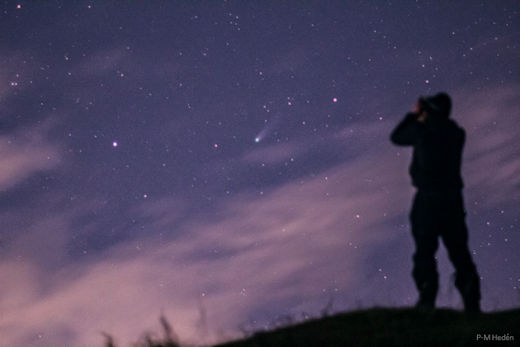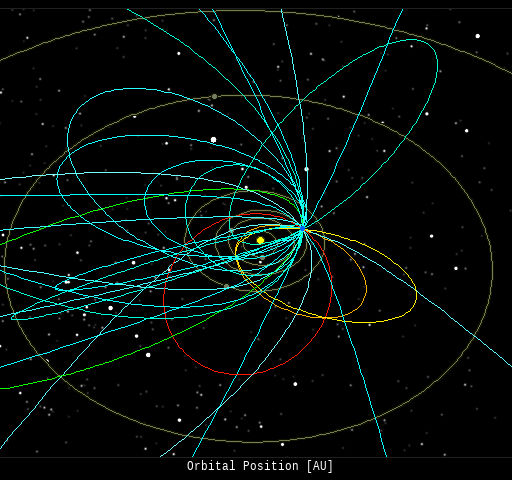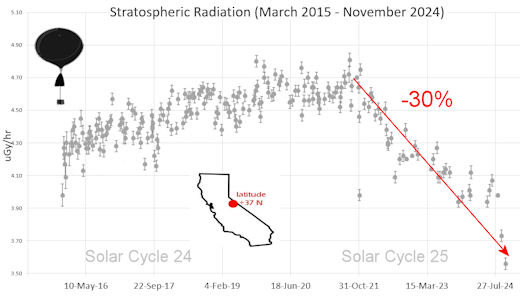This is an AI Free Zone: Text created by Large Language Models is spreading across the Internet. It's well-written, but frequently inaccurate. If you find a mistake on Spaceweather.com, rest assured it was made by a real human being.
|
|
|
GEOMAGNETIC STORM WATCH--DOWNGRADED: The failure of any CMEs to strike Earth on Oct. 16th has prompted NOAA to downgrade today's geomagnetic storm watch from G2 (Moderate) to G1 (Minor). The incoming CMEs were probably off-target. A belated glancing-blow could still spark Arctic auroras on Oct. 17th. CME impact alerts: SMS Text.
COMET LEMMON IS APPROACHING EARTH: On Oct. 21st, Comet Lemmon (C/2025 A6) will make its closest approach to Earth. The brightening comet has reached magnitude +4.5, making it an easy target for off-the-shelf cameras. "Here’s a quick shot with my old 135mm Pentax Takumar," says P-M Hedén of Vallentuna, Sweden:

"I managed to see the comet through binoculars and it was a beautiful sight," says Hedén. "I could see part of the tail, too, beside the classic green ball."
At closest approach, the comet will be 0.6 AU away--not super close, but near enough to vault the comet to naked-eye visibility at 3rd or 4th magnitude. Even cell phones with night-sky photo settings should be able to catch it.
Look for Comet Lemmon low in the northwestern sky after sunset. Its relatively low altitude in a dark sky will provide opportunities to frame it with a scenic foreground. Sky maps: Oct. 16, 17, 18, 19, 20, 21.
Realtime Space Weather Photo Gallery
Free: Spaceweather.com Newsletter
THE THOLIAN WEB: Readers of a certain age will remember The Tholian Web. It appeared in a 1968 episode of Star Trek (The Original Series). Captain Kirk was caught between dimensions while Spock and crew rushed to rescue him. At the same time, the Tholians weaved a destructive energy web around the Enterprise.
Fast forward to 2025, and the Tholian Web is real:

The checkerboard streaks in this image were photographed by Lorenzo Comolli of Saint Barthelemy, Italy. He was trying to take a picture of Comet Lemmon in September, but as the exposure time increased, more and more Starlink satellites crossed the field of view.
"It seems that the promise of Musk of dark satellites is completely void. They are really bright (2nd and 3rd magnitude)," says Comolli. "This makes me worry for the future quality of the sky."
He's right to worry. Right now, Earth is surrounded by about 8000 Starlinks with future plans calling for 42,000. Amazon’s Project Kuiper has begun launching its own planned 3,200-satellite broadband fleet, while China is building two more megaconstellations: Guowang (13,000 satellites) and "Qianfan" ("Thousand Sails", 15,000-plus). Together, they could eventually rival or surpass Starlink.
Who are the Tholians? You decide.
FOREVER ROSE FROM SPACE: This bloom will never wilt. The Forever Rose flew to the edge of space on Oct. 4, 2025, floating 101,875 feet above the Sierra Nevada Mountains of central California.

You can have it for $98.95. The 3-dimensional rose is laser etched inside a 2.3-inch diameter premium K9 crystal ball. The word "forever" is inscribed beneath the rose to denote eternal love. The stand is included, and it comes with a unique gift card showing the crystal ball at the top of Earth’s atmosphere.
Far Out Gifts: Earth to Sky Store
All sales support hands-on STEM education
Realtime Aurora Photo Gallery
Free: Spaceweather.com Newsletter
Every night, a network
of
NASA
all-sky cameras scans the skies above the United
States for meteoritic fireballs. Automated software
maintained by NASA's Meteoroid Environment Office
calculates their orbits, velocity, penetration depth
in Earth's atmosphere and many other characteristics.
Daily results are presented here on Spaceweather.com.
On Oct 16, 2025, the network reported 20 fireballs.
(14 sporadics, 2 epsilon Geminids, 2 Orionids, 1 October delta Aurigid, 1 lambda Draconid)

In this diagram of the inner solar system, all of the fireball orbits intersect at a single point--Earth. The orbits are color-coded by velocity, from slow (red) to fast (blue).
[Larger image] [movies]
Potentially Hazardous Asteroids (
PHAs)
are space rocks larger than approximately 100m that
can come closer to Earth than 0.05 AU. None of the
known PHAs is on a collision course with our planet,
although astronomers are finding
new
ones all the time.
On October 17, 2025 there were 2349 potentially hazardous asteroids.
 |
Recent
& Upcoming Earth-asteroid encounters:
| Asteroid |
Date(UT) |
Miss Distance |
Velocity (km/s) |
Diameter (m) |
| 2025 TW10 |
2025-Oct-12 |
9.7 LD |
18.3 |
36 |
| 2025 UC |
2025-Oct-12 |
6.7 LD |
6.9 |
16 |
| 2025 TS5 |
2025-Oct-12 |
6.6 LD |
19.1 |
22 |
| 2025 TU1 |
2025-Oct-13 |
5.9 LD |
7.5 |
18 |
| 2025 TV2 |
2025-Oct-13 |
3.3 LD |
7.5 |
14 |
| 2025 UA |
2025-Oct-14 |
10 LD |
4.1 |
11 |
| 2025 SC29 |
2025-Oct-14 |
14.9 LD |
6.7 |
18 |
| 2022 AY5 |
2025-Oct-14 |
7.4 LD |
8.4 |
5 |
| 2025 TZ4 |
2025-Oct-14 |
3.6 LD |
9 |
17 |
| 2025 TQ5 |
2025-Oct-15 |
1.1 LD |
5.4 |
9 |
| 2022 UY3 |
2025-Oct-15 |
10.2 LD |
7.4 |
15 |
| 2025 TO5 |
2025-Oct-15 |
2.1 LD |
8.3 |
20 |
| 2025 TP5 |
2025-Oct-15 |
0.3 LD |
8.4 |
17 |
| 2025 SX26 |
2025-Oct-16 |
8.6 LD |
8.4 |
21 |
| 2025 SQ27 |
2025-Oct-16 |
15.1 LD |
7.5 |
16 |
| 2025 SA73 |
2025-Oct-16 |
3.3 LD |
9.3 |
17 |
| 2025 TR2 |
2025-Oct-17 |
12.8 LD |
16.3 |
58 |
| 2025 UD |
2025-Oct-17 |
5.7 LD |
14.6 |
38 |
| 2022 UU15 |
2025-Oct-19 |
14.8 LD |
16.1 |
34 |
| 2025 TT10 |
2025-Oct-19 |
1.2 LD |
22.7 |
16 |
| 2025 UE |
2025-Oct-19 |
13.9 LD |
7.8 |
33 |
| 2025 TV10 |
2025-Oct-20 |
7.8 LD |
7.2 |
34 |
| 2025 TJ11 |
2025-Oct-20 |
7.2 LD |
13.1 |
25 |
| 2025 SD7 |
2025-Oct-21 |
9.9 LD |
12.5 |
55 |
| 2025 TQ10 |
2025-Oct-21 |
9.3 LD |
7.4 |
44 |
| 2023 UK3 |
2025-Oct-21 |
6.7 LD |
9 |
5 |
| 2025 TU4 |
2025-Oct-21 |
15.4 LD |
7.7 |
17 |
| 2025 TU10 |
2025-Oct-21 |
15.9 LD |
7.3 |
25 |
| 2025 UB |
2025-Oct-22 |
3.2 LD |
5.4 |
13 |
| 2024 GD2 |
2025-Oct-22 |
17.8 LD |
4.2 |
28 |
| 2025 TG11 |
2025-Oct-22 |
10.4 LD |
10.8 |
21 |
| 2022 HM1 |
2025-Oct-23 |
15.1 LD |
13.3 |
27 |
| 2025 TX2 |
2025-Oct-24 |
6.3 LD |
6.8 |
26 |
| 2012 TP231 |
2025-Oct-25 |
15.2 LD |
6.7 |
37 |
| 2020 FA5 |
2025-Oct-26 |
15.7 LD |
26.5 |
210 |
| 2009 HC |
2025-Oct-26 |
8.6 LD |
4.2 |
39 |
| 434196 |
2025-Oct-27 |
17.4 LD |
10.9 |
171 |
| 2025 TP11 |
2025-Nov-02 |
12 LD |
8.4 |
36 |
| 2023 VK6 |
2025-Nov-03 |
7.6 LD |
9.6 |
15 |
| 2021 VQ10 |
2025-Nov-08 |
9 LD |
15 |
13 |
| 2019 UH7 |
2025-Nov-08 |
13.3 LD |
5.8 |
11 |
| 2018 KC |
2025-Nov-09 |
16 LD |
9.3 |
11 |
| 2017 WG14 |
2025-Nov-09 |
16.7 LD |
11.7 |
45 |
| 2020 VK4 |
2025-Nov-10 |
16.4 LD |
3.8 |
9 |
| 2012 VC26 |
2025-Nov-11 |
13.3 LD |
6.4 |
6 |
| 2019 VL5 |
2025-Nov-14 |
14.7 LD |
9.1 |
24 |
| 2022 FG4 |
2025-Nov-17 |
18.7 LD |
22.2 |
105 |
| 3361 |
2025-Nov-19 |
14.8 LD |
9.1 |
435 |
| 2013 NJ4 |
2025-Nov-20 |
12.6 LD |
6.4 |
12 |
| 2021 WR |
2025-Nov-22 |
19.3 LD |
10 |
31 |
| 516155 |
2025-Nov-24 |
12.5 LD |
16.7 |
338 |
| 2020 WM |
2025-Nov-24 |
17.4 LD |
11.8 |
36 |
| 2019 UT6 |
2025-Nov-25 |
6.2 LD |
12.6 |
147 |
| 2018 WG2 |
2025-Nov-27 |
13.5 LD |
7.5 |
3 |
| 2007 VM184 |
2025-Dec-01 |
13.1 LD |
20 |
224 |
| 2018 WC2 |
2025-Dec-03 |
9.8 LD |
8.9 |
36 |
| 2021 JE1 |
2025-Dec-08 |
13.5 LD |
7.1 |
16 |
| 2019 XN3 |
2025-Dec-10 |
5.7 LD |
3.6 |
15 |
| 1999 SF10 |
2025-Dec-10 |
8.2 LD |
4.4 |
46 |
| 2016 YH |
2025-Dec-13 |
6.8 LD |
8.9 |
28 |
Notes: LD means
"Lunar Distance." 1 LD = 384,401 km, the distance
between Earth and the Moon. 1 LD also equals 0.00256
AU.
| |
Cosmic Rays in the Atmosphere |
SPACE WEATHER BALLOON DATA: Almost once a week, Spaceweather.com and the students of Earth to Sky Calculus fly space weather balloons to the stratosphere over California. These balloons are equipped with sensors that detect secondary cosmic rays, a form of radiation from space that can penetrate all the way down to Earth's surface. Our monitoring program has been underway without interruption for 10 years, resulting in a unique dataset of in situ atmospheric measurements.
Latest results (Nov. 2024): Atmospheric radiation is sharply decreasing in 2024. Our latest measurements in November registered a 10-year low:

What's going on? Ironically, the radiation drop is caused by increasing solar activity. Solar Cycle 25 has roared to life faster than forecasters expected. The sun's strengthening and increasingly tangled magnetic field repels cosmic rays from deep space. In addition, solar coronal mass ejections (CMEs) sweep aside cosmic rays, causing sharp reductions called "Forbush Decreases." The two effects blend together to bring daily radiation levels down.
.Who cares? Cosmic rays are a surprisingly "down to Earth" form of space weather. They can alter the chemistry of the atmosphere, trigger lightning, and penetrate commercial airplanes. According to a study from the Harvard T.H. Chan school of public health, crews of aircraft have higher rates of cancer than the general population. The researchers listed cosmic rays, irregular sleep habits, and chemical contaminants as leading risk factors. A number of controversial studies (#1, #2, #3, #4) go even further, linking cosmic rays with cardiac arrhythmias and sudden cardiac death.
Technical notes: The radiation sensors onboard our helium balloons detect X-rays and gamma-rays in the energy range 10 keV to 20 MeV. These energies span the range of medical X-ray machines and airport security scanners.
Data points in the graph labeled "Stratospheric Radiation" correspond to the peak of the Regener-Pfotzer maximum, which lies about 67,000 feet above central California. When cosmic rays crash into Earth's atmosphere, they produce a spray of secondary particles that is most intense at the entrance to the stratosphere. Physicists Eric Regener and Georg Pfotzer discovered the maximum using balloons in the 1930s and it is what we are measuring today.
| |
The
official U.S. government space weather bureau |
| |
The
first place to look for information about sundogs,
pillars, rainbows and related phenomena. |
| |
Researchers
call it a "Hubble for the sun." SDO
is the most advanced solar observatory ever. |
| |
3D
views of the sun from NASA's Solar and Terrestrial
Relations Observatory |
| |
Realtime
and archival images of the Sun from SOHO. |
| |
information about sunspots based on the latest NOAA/USAF Active Region Summary |
| |
current counts of failed and deployed Starlink satellites from Jonathan's Space Page. See also, all satellite statistics. |
| |
Authoritative predictions of space junk and satellite re-entries |
| |
from
the NOAA Space Environment Center |
| |
fun to read, but should be taken with a grain of salt! Forecasts looking ahead more than a few days are often wrong. |
| |
from the NOAA Space Environment Center |
| |
the
underlying science of space weather |
 |
Got a chipped or cracked windshield that prevents you from seeing space weather events while driving? Get windshield replacement from SR Windows & Glass with free mobile auto glass service anywhere in the Phoenix area. |
| |
These links help Spaceweather.com stay online. Thank you to our supporters! |
|
|
| |
|
|
|